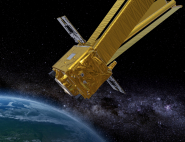Newton
UNIVERSAL GRAVITATION (1687)
TNewton’s law of universal gravitation unifies knowledge of the laws of motion.
![]()
Isaac Newton (1642-1727)
Newton was familiar with Galileo's works, especially those on inertia. His name has gone down in history as the first scientist to state the law of universal gravitation. Simultaneously valid for the sublunary world that surrounds us and for the world of stars, this law meant that gravitation made a major philosophical impact owing to its universal character. The law of gravitation was published in 1687 in "Mathematical Principles of Natural Philosophy". It stipulates that:
- All bodies attract each other by a force pointing along the line intersecting both bodies
- This force is proportional to the product of the two gravitational masses of the bodies and inversely proportional to the square of the distance between them
![]()
The gravitational force which the first body exerts on the second is the same as that which the second body exerts on the first.
A “MANUAL” PRINCIPLE (1687)
To take into account the universality of free fall which he had observed, Newton incorporated the equivalence principle in his equations "by hand".
Newton's theory of gravitation introduced the concept of gravitational mass (mg). When he established his mechanics, he followed Galileo and introduced inertia, which means the ability of a body to maintain a state of uniform motion. For a given material, this inertia—or inertial mass—is proportional to the quantity of matter. The inertial mass (mi) was defined precisely by Newton when he wrote that the force is the product of inertial mass times acceleration: F = mi × a.
A priori, these two masses are not related, since the gravitational mass implies the faculty of being attracted by another gravitational mass. Let us suppose that the considered force is gravitational. Then we have the relation:
mi × a = mg × g, where g is the field of gravity.
The acceleration of a body is thus a = g × mg / mi.
If the ratio of these two masses is constant and does not depend on the composition, the acceleration—and thus the motion—of two bodies is identical. As observed from the experiments done by Galileo and Newton, the fall of two bodies is identical. Therefore, the ratio of the two masses is a constant (in the system of units used, this constant is unity).
Newton thus incorporated the principle of equivalence in his laws "by hand" by stating the equality between gravitational and inertial masses. To understand the mysterious origin of this equality, Newton tried to verify the universality of free fall, notably by improving the pendulum method invented by Galileo.
![]()
The law of equal areas, established by Kepler in 1609, is a consequence of the law of universal gravitation. According to this law, while orbiting around the Sun, any planet sweeps out an area which is directly proportional to the duration. For very elliptical orbits, as here, the consequence is a significant acceleration of planetary motion when close to the Sun.
NEWTON’S PENDULUMS (CIRCA 1680)
Newton improves testing of the equivalence principle using the pendulum method.
Using the innovations introduced by Galileo, Newton closely examined the effects of air friction on motion. He showed that this resistance is proportional to the speed squared (which is the relation that we still know today). He built two identical pendulums, one out of wood serving as the reference, and the other from different materials. Starting the pendulums simultaneously, he measured how long it took before a difference in their motion could be detected. Through meticulous experimentation and by taking into account the effect of air resistance, Newton showed that the motion of a pendulum is independent of its material with a relative accuracy of 10-3.
The test of the equivalence principle by pendulum experiments has been improved over the centuries. Friedrich Bessel verified it in 1830 with a relative accuracy of 10-5, and in 1923 Harold Potter even achieved a relative accuracy of 10-6. However, at that time, this test was supplanted by another method which is still used today—the torsion pendulum.
![]()
Friedrich Bessel

